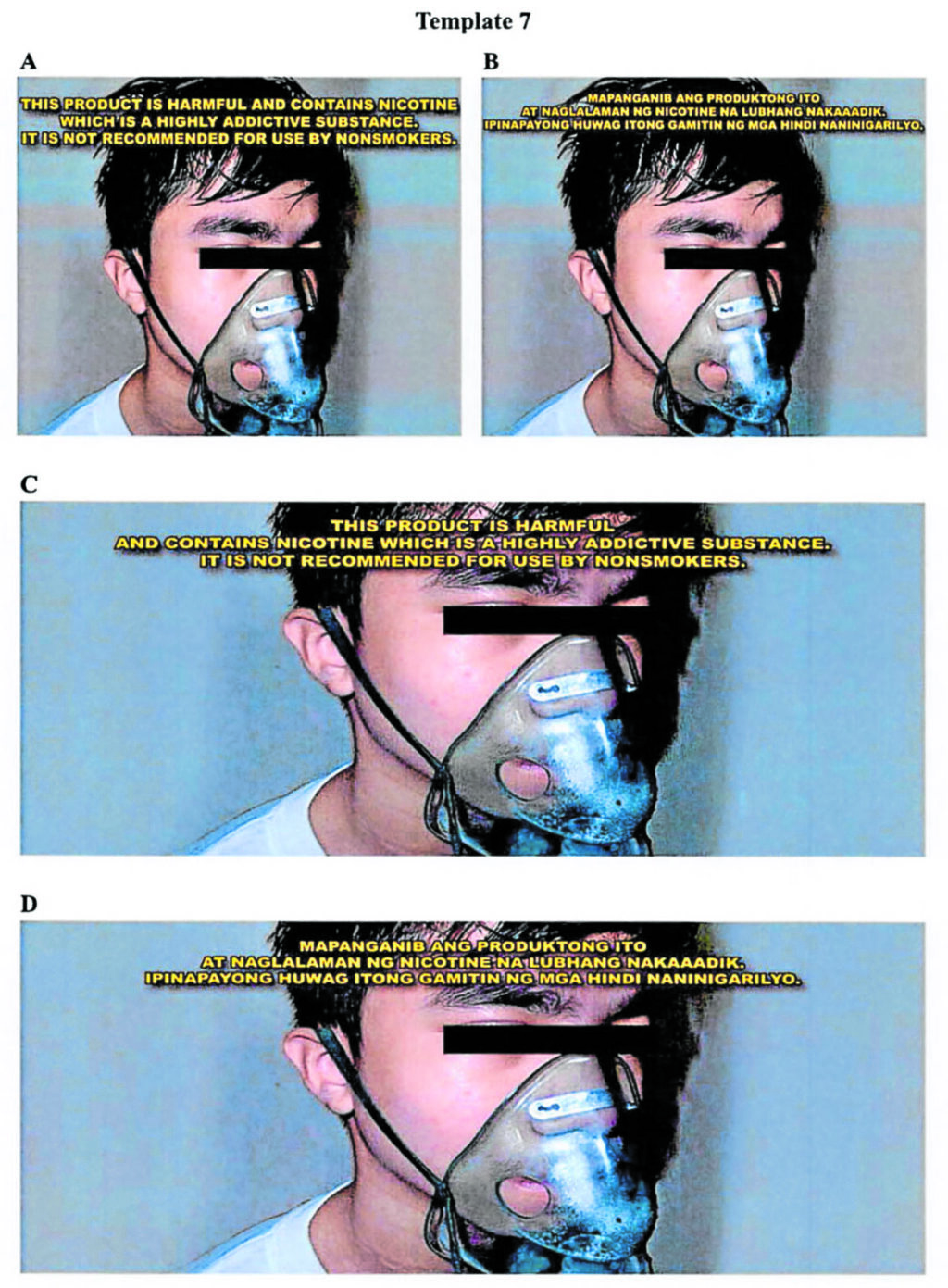
DON’T WASTE YOUR BREATH Some of the template health warnings that will appear in e-cigarettes and vapes show a young man in an oxygen mask, to demonstrate their harmful effect on one’s lungs. —PHOTO FROM DEPARTMENT OF HEALTH
Starting next month, all electronic cigarettes and vapes sold in stores and online in the Philippines will have graphic health warnings (GHWs) on their packaging.
This is to discourage Filipinos, especially young people, from using these harmful products. The Department of Health announced this policy, which will begin on May 12. It applies to all vaporized nicotine and non-nicotine products, as well as novel tobacco products like vapes.
READ: Tobacco packaging: Getting PH youth hooked on smoking, vaping
According to the health agency, the GHWs shall eat up half the packaging material of vapes and literally show the harm that smoking these products can do to the human body.
Along with antismoking groups, the DOH said it was optimistic that the campaign could replicate the success of GHWs in cigarette packaging in lowering the number of tobacco users in the country.
The enforcement of mandatory warnings on vape products came almost two years after the DOH issued in October 2022 administrative orders on the guidelines and first set of templates for GHWs.
Dry eyes, scarred lung
Republic Act No. 11900, or the Vaporized Nicotine and Non-Nicotine Products Regulation Act, which lapsed into law on July 25, 2022, effectively transferred the regulation of vaping products from the Food and Drug Administration, an agency under the DOH, to the Department of Trade of Industry (DTI).
But under Section 4 of RA 11900, the DOH is mandated to develop the revised guidelines and produce the templates for the effective implementation and application of the GHWs on vaping products.
The guidelines for the GHWs on vape products are consistent with the GHWs on cigarette and tobacco products under RA 10643, or the Graphic Health Warnings Law, enacted in 2014.
The DOH released 12 first set of template GHWs for vaping products, including close-up images of dry, itchy red eyes, an immediate or near-term effect of vaping; a dry mouth with lesions caused by the chemical propylene glycol in vaping juices; and a damaged and scarred lung.
One image shows a bloodied and mangled hand caused by the explosion of e-cigarette and vape products, while another shows a patient wearing an oxygen mask in a hospital bed.
Textual warning
A warning in both Filipino and English is superimposed on the graphic images: “Maaaring naglalaman ng mapanganib na sangkap ang produktong ito. Ipinapayong huwag itong gamitin ng mga hindi naninigarilyo (This product may contain a substance that is harmful. It is not recommended for use by nonsmokers).”
Based on the DOH Administrative Order No. 2022-0046, the GHWs shall be printed on at least 50 percent of the lower portion of principal display surface on both the back and front of the packaging of the vaping product—be it round or disc-type, or wide or standard box type packaging.
There should also be textual warning in English and Filipino stating: “Quit tobacco use! Call DOH hotline 1558” and “Not for persons below 18 years old,” which occupies 30 percent of the packaging’s side panel.
Under RA 11900, only duly registered e-cigarettes and vape products with the applicable GHWs are allowed to be sold, advertised or distributed in the country.
Manufacturers, distributors, importers and retailers of vaporized nicotine and non-nicotine products and novel tobacco products found guilty of failure to comply with the law face up to six years in prison and a maximum fine of P5 million.
Companies that violate the law shall also have their business permits and license to operate be canceled and revoked, while foreigners shall be deported.
The DOH also urged the public to report physical or online shops which do not have GHWs on the packaging of their vape products through https://bit.ly/VapeViolationsReporting.
Shops not complying with the required GHWs on vape products may also be reported through an email message to the DTI at consumercare@dti.gov.ph.
Proof of violation
Online reporting may be done anonymously, but proof of violation of the GHWs, including photo or video recording, must be uploaded.
Based on the results of the latest Global Youth Tobacco Survey in 2019, 14 percent, or one in every seven Filipinos age 13 to 15 years old, uses e-cigarettes, equivalent to almost a million young users in the country.
But the DOH and medical experts believe the figure might have “grown even larger” in the past five years.
The Expanded National Nutrition Survey released by the Food and Nutrition Research Institute in 2019 revealed that one of five vape users in the country, or 20 percent, are adolescents.
Health Secretary Teodoro Herbosa earlier said he would ask the Department of Education to assist in an intensified information drive among the youth about the health risks of using e-cigarettes or vaping products.
He also urged the Philippine National Police, especially its Anti-Cybercrime Group, to go after online vendors and retailers selling vaping products to minors.